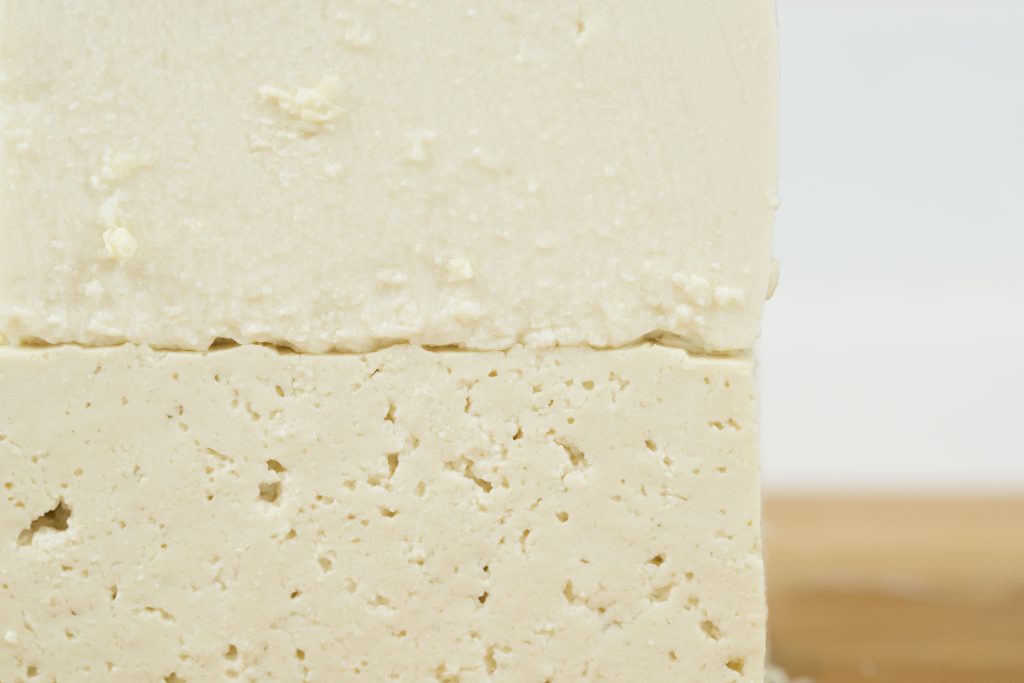
One of the most mysterious characteristics of Tofu is it’s consistency. What is it exactly, that defines whether tofu will be elastic or silky? In order to understand that, we first need to solve another puzzle, and that is to get behind the magic that transforms soymilk into Tofu. The answer is simple. All it takes is some coagulant. This is also why Tofu has actually originated as an accidental creation. With coagulants being natural products occurring for example in seawater or salt lakes, one can imagine how they were once somehow mixed in with soymilk, creating tofu.
Bei vielen führt der Begriff Koagulation schon zu viel Verwirrung, dabei braucht man kein# Chemiestudium um zu verstehen, was Koagulationsmittel überhaupt sind und welchen Prozess sie entfachen. Koagulationsmittel sind Chemikalien, die frei im Wasser verteilte Moleküle dazu bringen, zusammen zu klumpen. So werden Feststoffe und Wasser voneinander getrennt – ein Prozess, den man auch Koagulation nennt. Der chemische Prozess der hinter Koagulation steckt ist folgender: Wenn ein Koagulationsmittel zu der Mischung hinzugegeben wird, werden durch die positiven Ladungen der Koagulationsmittel die negativ geladenen Moleküle der Feststoffe neutralisiert. Durch diese negativen Ladungen wurden vorher die Moleküle auseinandergehalten. Das Koagulationsmittel ermöglicht es uns dann, die seidige Tofu Masse aus dem Wasser zu heben und zum Pressen in die Box zu füllen.
Nun haben wir bereits den ersten Teil dieses Rätsels gelöst, und zwar der Vorgang bei dem Sojamilch zu Tofu wird. Nun fragen sich jedoch immer noch viele: Wie kann es sein, dass mancher Tofu an Pudding erinnert, während anderer Tofu, wie zum Beispiel der den man in einer Gemüsepfanne vorfindet, eine viel festere Konsistenz hat? Die mysteriöse Kraft die dahinter steckt, ist welches Koagulationsmittel benutzt wurde. Insgesamt gibt es zwei verschiedene Koagulationsmittel die für die Tofuherstellung verwendet werden. Die populärsten Koagulationsmittel sind Koagulationssalze, wovon es zwei verschiedene gibt: Magnesiumchlorid und Calciumsulfat. Der Vorteil von Magnesiumchlorid (Nigari) ist, dass der Tofu der dabei entsteht, aus weniger Wasser zusammengesetzt ist. Somit hat dieser Tofu eine viel festere Konsistenz. Wer Calciumsulfat benutzt, bekommt ein Endprodukt, wo vergleichsweise mehr Wasser drin ist, was zu einer weichen, gleichmäßigen Tofu-Struktur führt. So überrascht es nicht, dass fast aller Seidentofu auf dem Markt mit Calciumsulfat gemacht wurde. Viele Tofu Marken kombinieren jedoch beide Koagulationsmittel, um Geschmack und Form zu optimieren. Koagulationsmittel verfügen darüber hinaus jedoch über einen weiteren Vorteil, und zwar beinhalten sie zahlreiche Nährstoffe, weshalb sie auch oft als Nahrungsergänzungsmittel angeboten werden.
Another coagulant that can transform soymilk into tofu are edible acids, for example citric acids or vinegar. However, since the coagulant does not only determine the consistency, but also the taste of the tofu, using acids will most likely result in a very sour taste. Salt coagulants on the other hand deliver a tofu that is much sweeter in taste. Overall, tofu produced with salt coagulants is smoother and more elastic, with pores, while the tofu made with acid does not have any pores and is a lot more solid. It’s texture can be compared to that of feta cheese.
All in all, it can be said that tofu is not only defined by the soybeans used and their grinding process, but also by the coagulant of your choice. The picture below shows the difference again: the tofu on the top is silky tofu and the tofu at the bottom is firm tofu.
